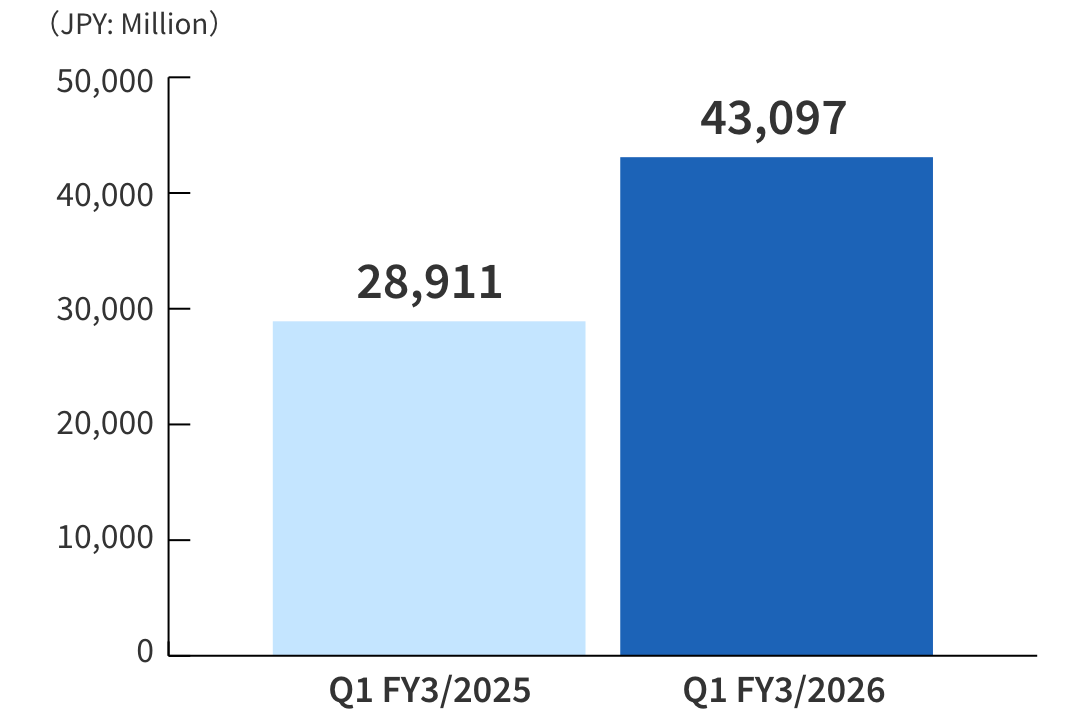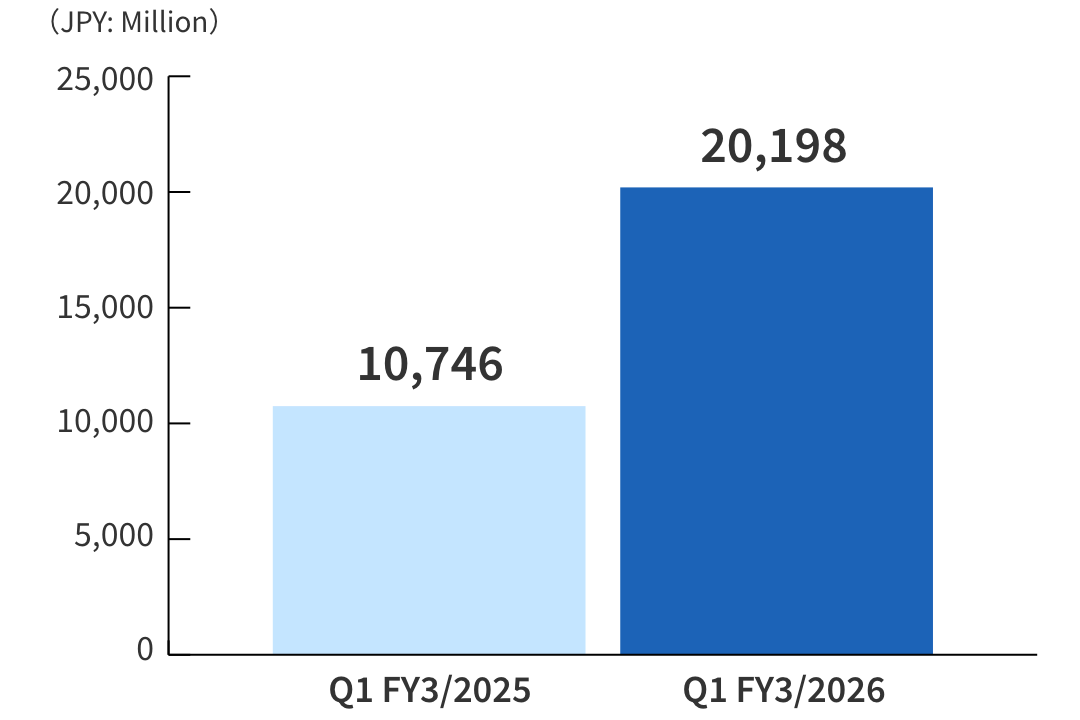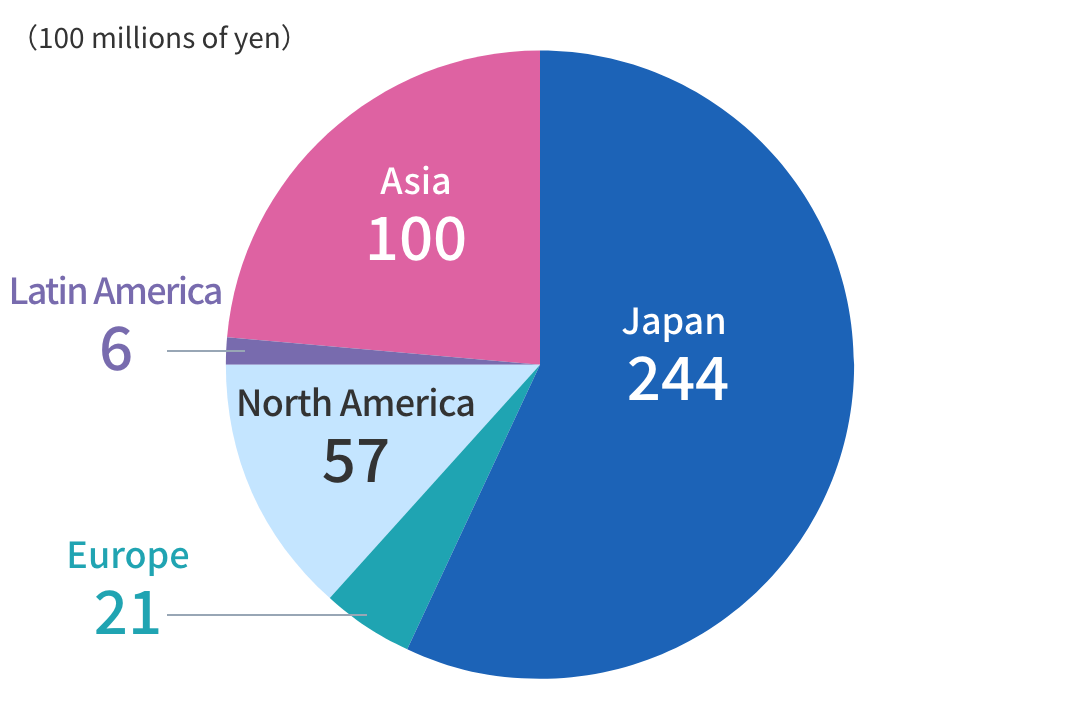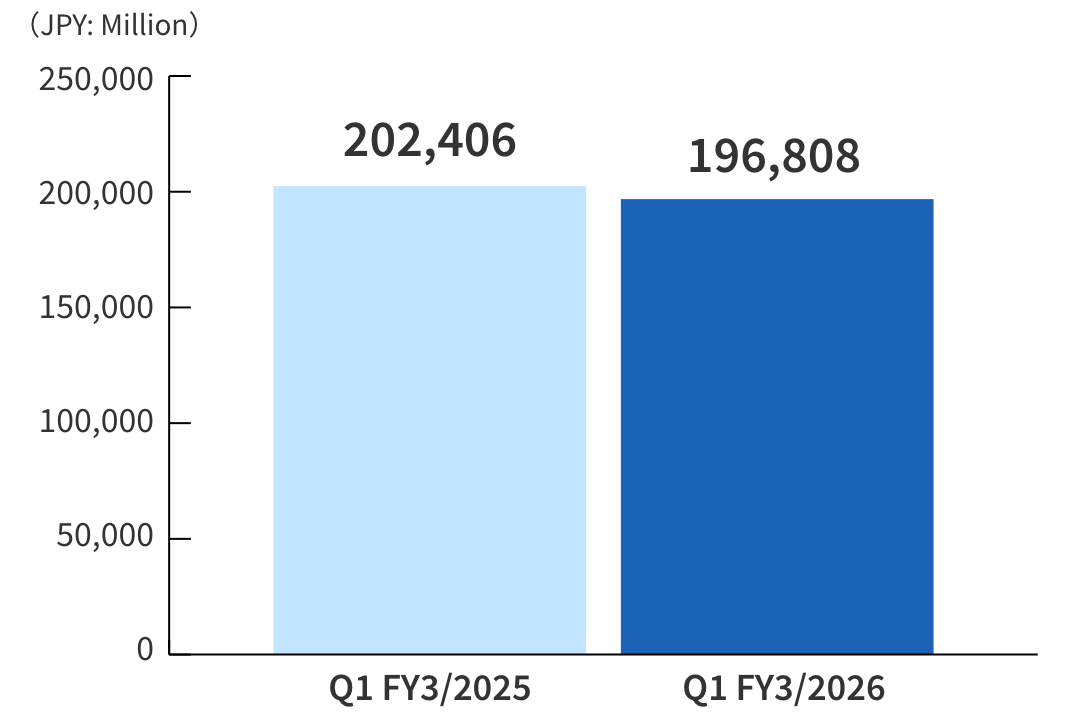Explanation of Results of Operations (1H of FY3/2026)
Summary
(JPY: Million)
| Net Sales | 87,676 | YoY+39.6% |
|---|---|---|
| Operating Profit | 39,183 | YoY+66.1% |
| OP Margin | 44.7% | ー |
| Ordinary Profit | 39,715 | YoY+64.1% |
| Profit attributable to owners of parent | 27,518 | YoY+44.3% |
| Basic Earnings per Share | 115.21Yen | ー |
|---|
- Consolidated net sales and operating profit for the first half of FY3/2026 exceeded the forecasts announced in August, with both reaching record highs
- Collaboration initiatives with Expo 2025 Osaka Kansai and other high brand value partners drove domestic performance growth
- Revised full-year forecasts upward in light of strong first-half results
【Summary for 1H of FY 3/2026】
- Adjusted operating profit for the first half exceeded the full-year forecast announced on August 8, 2025, reaching 37.1 billion yen, up 49.9% year on year. The increase was driven by stronger-than-expected sales in the Product Sales and Licensing in Japan businesses, as well as lower-than-expected SG&A expenses.
- The domestic Product Sales and Licensing businesses benefited not only from collaborations related to Expo 2025 Osaka Kansai, but also from ongoing target-client strategies, including collaboration initiatives with major licensees and the rollout of multiple characters. The domestic Product Sales and Theme Park businesses saw year-on-year increases in customer traffic and average spending per person, driven mainly by the roll out of limited-edition series and seasonal campaigns.
- China continued to drive growth in the overseas Licensing business, with multi-character strategies progressing in the country. Globally, continued promotion of Sanrio characters using digital tools led to expansion in product categories and lineups, as well as increased use of multiple characters. In North America, net sales increased year on year due to ongoing strong momentum, despite market concerns over tariff impacts; however, adjusted operating profit declined due to higher SG&A expenses mainly stemming from increased marketing investments.
Net Sales
(JPY: Million)
| Net Sales | 87,676 | YoY+39.6% |
|---|

Consolidated net sales and operating profit for the first half of FY3/2026 exceeded the forecasts announced in August, with both reaching record highs
Operating Profit
(JPY: Million)
| Operating Profit | 39,183 | YoY+66.1% |
|---|

Operating profit for the first half exceeded the full-year forecast announced on August 8, 2025, reaching 39.1 billion yen, up 66.1% year on year.
Reportable Segment
Segment Sales Ratio

i. Japan: Net sales rose 34.9% year-on-year to 52.2 billion yen and operating profit rose 53.3% to 25.4 billion yen.
In the product sales business, a wide range of Sanrio characters received strong support across various age groups. These included anniversary characters such as Kuromi and My Melody, as well as Pompompurin, who won first place in the Sanrio Character Awards. As a result, sales far surpassed the previous year’s levels across various channels, including retail stores, e-commerce sites, and wholesale. The number of foreign tourists as well as domestic customers rose substantially, especially at retail stores. Both the average spending per customer and the total number of customers continued to increase. Moreover, our efforts in recent years to improve store operations, including strengthening the supply system through automated ordering of standard products and increasing the number of checkout counters, have proved effective.
In the licensing business, our strategy for a wide range of Sanrio characters proved effective, while inbound demand and the 2025 Japan International Exposition (Expo 2025 Osaka, Kansai) also contributed to business growth. Characters celebrating anniversaries, such as My Melody and Kuromi, and Hapidanbui enjoyed strong popularity. Meanwhile, the Hello Kitty exhibition touring Japan, “As I Change, So Does She,” (Okinawa Prefectural Museum & Art Museum: March 7–May 11, 2025; Fukuoka Art Museum: June 24–August 31, 2025) drew significant public attention.
Operating profit rose due to an increase in sales.
ii. Europe: Net sales rose 131.6% year-on-year to 4.5 billion yen and operating profit rose 173.1% year-on-year to 1.2 billion yen.
In the licensing business, sales rose significantly, driven by the continued strategy of featuring a wide range of Sanrio characters and successful initiatives with global brands. In particular, growth was led by the apparel category, which benefited from partnerships with major fast fashion brands, and the toy category, which also featured a wide range of Sanrio characters.
Operating profit increased due to sales growth.
iii. North America: Net sales rose 12.0% year-on-year to 10.9 billion yen and operating profit rose 62.1% yearon-year to 3.4 billion yen.
The licensing business saw significant sales growth in the toy, apparel, and digital categories. In the toy category, plush toys, character figures, and other products of major toy manufacturers performed well. The apparel category continued to expand its product lineup for the mass market (such as large retail chains) through initiatives with existing licensees. In the digital category, the launch of game content featuring a wide range of Sanrio characters across additional platforms contributed to increased sales and higher brand awareness.
Additionally, as part of its initiatives to enhance brand value and expand customer touchpoints, the Group held several sports events. These included events in partnership with professional sports leagues such as MLB (baseball), NHL (ice hockey), and NBA (basketball).
Operating profit increased due to higher sales despite an increase in marketing expenses.
iv. Latin America: Net sales rose 79.6% year-on-year to 1.2 billion yen and operating profit rose 92.7% year-onyear to 0.4 billion yen.
In Latin America as a whole, the licensing business performed well in the categories of apparel, health & beauty, stationery, accessories and bags. Moreover, characters other than Hello Kitty grew in popularity, including My Melody, which is marking its 50th, and Kuromi, which is celebrating its 20th anniversary.
In Mexico, strong performances were seen in the stationery category, especially desk supplies for children and teenagers, and the apparel category, including T-shirts. In Brazil, higher sales were driven by the health & beauty category, due to the success of a lip balm created in collaboration with a major pharmaceutical company. The apparel category also saw higher sales of merchandise featuring Kuromi amid its growing popularity. In Peru, sales were driven by the bag category, where durable suitcases are popular, and the apparel category.
Operating profit increased due to sales growth.
v. Asia: Net sales rose 60.6% year-on-year to18.6 billion yen and operating profit rose 96.2% to 10.2 billion yen.
In China, licensing business sales in the toys & hobby, apparel and accessories and household product categories were strong. The popularity of Hello Kitty continued. Due to the success of the strategy for a wide range of Sanrio characters, Kuromi and Cinnamoroll also maintained strong popularity and there was a growing attention to Hangyodon and Marumofubiyori. In the product sales business, the opening of new stores and pop-up shops successfully increased customer touchpoints, leading to a significant increase in sales.
In South Korea, the apparel and accessories categories within the licensing business saw sluggish performance due to weaker demand for apparel items. Meanwhile, the health & beauty category remained strong, driven by a strategy promoting a wide range of Sanrio characters.
In Taiwan, the licensing business performed well in the toy, apparel and food categories. The strategic deployment of a wide range of Sanrio characters proved successful. Notably, the popularity of My Melody and Kuromi has further increased.
In the Hong Kong and Macau region, the licensing business saw growth in sales, driven by the success of the corporate special sales category, which implemented initiatives in collaboration with financial institutions and local governments.
In Southeast Asia, sales of the licensing business were driven by multi-regional expansion through toy licensees. The corporate special sales category also performed well, contributing to sales growth. While maintaining the strong performance of Hello Kitty, the popularity of a wide range of Sanrio characters also grew, leading to sales growth in the toy and food categories.
Operating profit increased due to sales growth across Asia.
Explanation of Financial Position
(JPY: Million)
| Total Assets | 214,108 | YoY+5.8% |
|---|---|---|
| Net Assets | 144,530 | YoY+34.3% |
| Equity Ratio | 67.2% | ー |
Total Assets
(JPY: Million)
| Total Assets | 214,108 | YoY+5.8% |
|---|

At the end of the second quarter of the current fiscal year, total assets stood at 214.1 billion yen, an increase of 11.7 billion yen from the end of the previous fiscal year. The main increases were 5.0 billion yen in cash and deposits, 3.0 billion yen in merchandise and finished goods, 0.6 billion yen in other accounts receivable, 1.2 billion yen in other current assets, 1.1 billion yen in intangible assets, and 1.7 billion yen in investment securities. The main decrease was 1.2 billion yen in accounts receivable-trade.
Liabilities decreased 25.2 billion yen from the end of the previous fiscal year to 69.5 billion yen. The main increases were 2.3 billion yen in notes and accounts payable-trade and 1.4 billion yen in contract liabilities. The main decreases were 0.8 billion yen in income taxes payable, 5.7 billion yen in other current liabilities, and 23.0 billion yen in long- and short-term borrowings, bonds payable (including current portion of bonds payable) and convertible-bond-type bonds with share acquisition rights.
Net Assets
(JPY: Million)
| Net Assets | 144,530 | YoY+34.3% |
|---|

Net assets increased 36.9 billion yen from the end of the previous fiscal year to 144.5 billion yen. The main increases were 19.6 billion yen in retained earnings, 12.6 billion yen in capital surplus due to exercise of rights convertible-bond-type bonds with share acquisition rights, and 7.8 billion yen in treasury shares. The main decrease was 2.5 billion yen in foreign currency translation adjustment.
As a result, the equity ratio was 67.2%, up 14.3 percentage points from the end of the previous fiscal year.